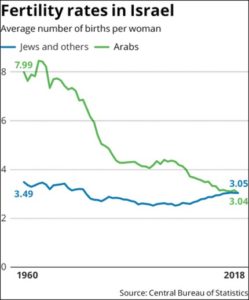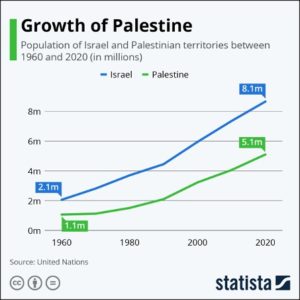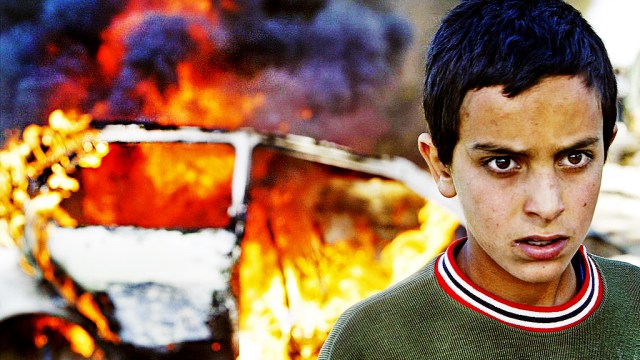What will he become? (Photo by David Silverman/Getty Images)

The latest cycle of violence in Israel-Palestine might appear to be over, but a pivotal dimension of the conflict remains unresolved: the matter of population. The Israelis and Palestinians are not only engaged in a never-ending territorial struggle, but a demographic one, too.
Israel-Palestine is a distinctive region because it combines low infant mortality and high female education with high birth rates. As Paul Morland has pointed out, Jews and Arabs in the region have much higher birth rates than their “co-ethnics” outside it. For instance, Arab women in Jordan bear 2.69 children, while those in Palestine have 3.49; Jewish women in Israel average 3.17 children each, compared to 1.5 in the US and Britain.
Why is this? One explanation seems to be that birth rates are higher in regions of religious conflict — a hypothesis that also seems to map on to areas inside Israel-Palestine. For example, Arab women in relatively conflict-prone Gaza average 3.64 kids compared to 3.07 in the more peaceful West Bank. Jewish women in tense, religious Jerusalem average 4.27 compared to a national average of 3.17.
What’s particularly concerning, though, is how these high fertility rates further increase the risk of violence, producing a dangerous, combustible spiral. How so?
First of all, political demographers have long identified a relationship between population composition, politics and violence. Young men, due in part to testosterone, commit a vastly disproportionate share of murders in all societies. Indeed, statistical models show that the higher the share of a nation’s population made up of 15-30 year olds, the greater the risk of a violent conflict.
In Sons and World Power, Gunnar Heinsohn analysed this trend throughout history, arguing that surplus males have always played an important part in spurring conquest and aggression. When only the eldest son inherited land, those with the bad luck to be his siblings had to fend for themselves. And so, he explained, during periods when population growth exceeded peaceful economic opportunities, war, banditry and risk-taking became more attractive.
That’s why the ranks of invaders, from the Vikings to Conquistadors, have disproportionately featured men such as Pedro de Alvarado, a younger son from a lesser-noble background who had no inheritance and thus decided, in 1510, to seek his fortune in the New World.
By contrast, as the population of the rich world ages, nations such as China, Russia and the United States will become increasingly unwilling to sacrifice their only sons on the battlefield, producing what Mark Haas has called “geriatric peace”. Indeed, Heinsohn argued that a major reason Lebanon did not descend into full-scale war in 2006, but did so in 1975, was age structure: by 2006, its fertility rate had plummeted and its average age had matured considerably compared to 1975.
Back in Israel, the issue of population has always commanded a central role in the nation’s psyche. First, Zionists worked hard to entice and sponsor European Jews to settle in the Holy Land, with the number of Jews swelling from 60,000 in 1918 to 600,000 in 1948. After the creation of Israel in 1948, waves of immigrants arrived, first from Displaced Persons camps in Europe, then from Morocco and, after 1989, from the former Soviet Union. Without immigration, as Paul Morland notes, there would be 250,000 Jews in Israel instead of 6 million.
And these ethno-demographic considerations are woven into national policy; they shaped Israel’s border wall and helped convince Ariel Sharon to withdraw from Gaza in 2005, which contains just 1% of the territory of Israel-Palestine but over one million Palestinians.
At one time, Israeli planners became concerned that Jews would be steadily outnumbered because of the Arabs’ fertility advantage — a prospect celebrated by Palestinian leaders. In the immortal words of the PLO’s Yasser Arafat, “the womb of the Arab woman is my strongest weapon”. For American political scientist Monica Toft, the two sides were engaged in “wombfare” for control of territory and power.
But while demographers once thought that Palestinian fertility would diverge from the Jewish fertility rate, Palestinian women have been affected by the worldwide slide in Arab birth rates of the past few decades. Meanwhile, Figure 1 (below) shows that while Jewish fertility was trending downward from the 1960s to the mid-1990s, it has since defied the supposedly iron laws of demography, going into reverse to the point that the Jewish fertility rate has now overtaken the falling Palestinian one.

Yet the rise in Jewish fertility has come at a price. Secular Jews and those from moderate branches have historically made up Israel’s elite, but are losing population share due to their relatively low fertility. Instead, the Jewish fertility rise is largely due to the growth in highly religious Jews, especially the Haredim, or ultra-Orthodox. The latter have doubled their share of the adult Jewish population in Israel since 2000, and are extremely young, forming a third of Jewish first-graders — up from a few percentage points in 1960. Though they currently only make up 10% of the American and British diaspora, they are expected to form a majority of observant American and British Jews by 2050.
Within Israel, this demographic shift is already starting to cause tensions. Ultra-Orthodox Jewish men generally avoid full-time jobs and the military, and are instead encouraged to study the Torah at Yeshivas to fulfil the ideal of a “scholar society”. The Israeli Central Bank, as a result, fears that their growth will ultimately bankrupt the Israeli state.
Modern Orthodox Jews are, by contrast, successful and serve enthusiastically in the Israeli Defence Force (IDF). While the ultra-Orthodox are reluctant or pragmatic Zionists, the modern Orthodox are often passionately so, making up an increasing share of IDF officers and serving as shock troops of the Religious Zionist and Settler movements.
But while ultra-Orthodox Jews rear between 6 and 7 children, modern Orthodox women have 3 or 4 — higher than the secular Jews, who have 2.2. This dynamic is having a number of consequences. First, the relatively poor ultra-Orthodox population is spilling out from concentrated areas such as Meah Shearim, near Jerusalem. A relatively inexpensive option is to move across the Green Line into East Jerusalem or to the Settlements in the occupied territories.
There are political repercussions, too. With their increased vote-share, the Ultra-Orthodox have shifted Israel in a more Right-wing and religious direction, generating increased support for Haredi and pro-Settler parties. This, in turn, makes it more difficult for the Government to trade occupied land — and the settlements of religious Jews which now stand on it — for peace.
Meanwhile, the still-healthy Palestinian fertility rate has resulted in a young and fast-growing population in the West Bank, where the median age is 22, and Gaza, where it is just 18. Indeed, Gaza is the 13th fastest growing political unit in the world, with a population density of over 5,000 people per square kilometre.

As Figure 2 (above) shows, this, together with Jewish fertility, has resulted in a soaring population in Israel-Palestine. While it is far too crude to describe the region as a ticking time bomb, it’s equally difficult to see how this population boom can continue without resulting in increased pressure on land, as well as producing a surplus of young men willing to join militant groups.
How will this all end? In the long run, it seems possible that the ultra-Orthodox could bankrupt Israel, while Palestine may have to send its excess population to work abroad if Arab countries in the Persian Gulf once again become willing to accept large numbers of Palestinians. The region’s demographic struggle for power is heating up — and, despite yesterday’s ceasefire, it doesn’t look like it will be brought to an end anytime soon.










Join the discussion
Join like minded readers that support our journalism by becoming a paid subscriber
To join the discussion in the comments, become a paid subscriber.
Join like minded readers that support our journalism, read unlimited articles and enjoy other subscriber-only benefits.
Subscribe